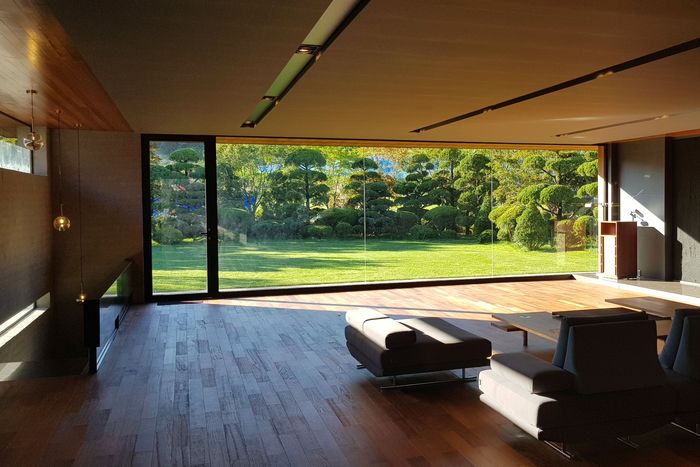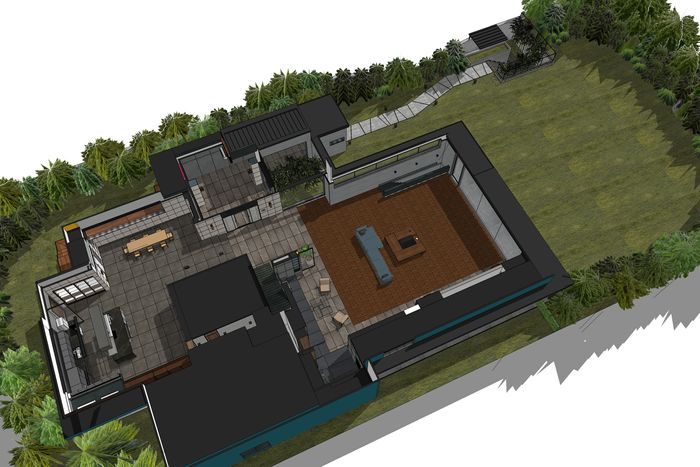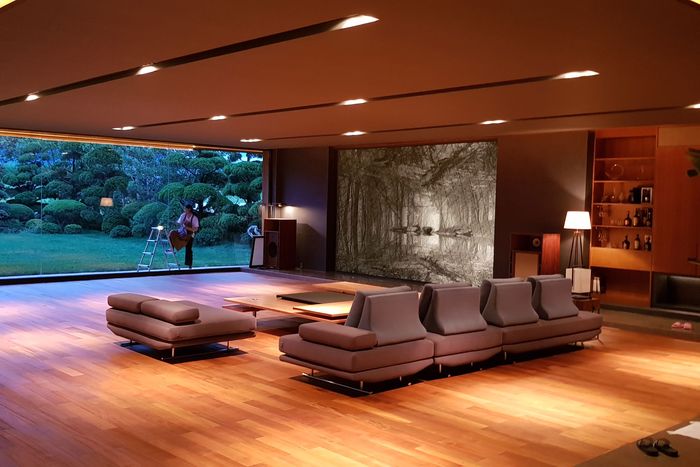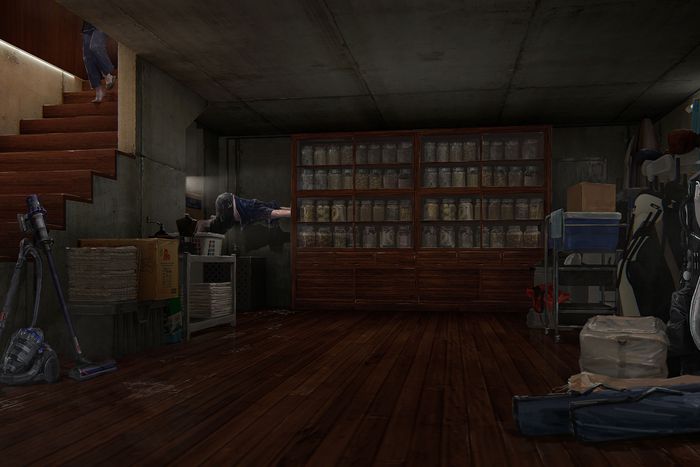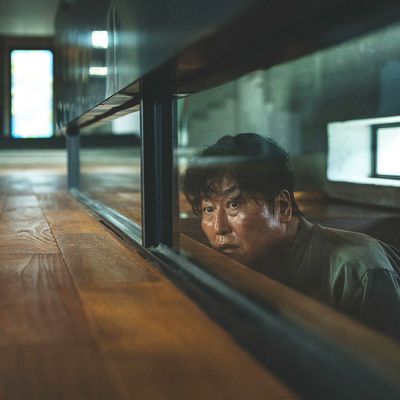
What’s in a house? Much of the shock and thrill in Bong Joon Ho’s genre-flexible movie Parasite — nominated for six Oscars including Best Production Design — hinges on the fictional house built by a fictional architect owned by the wealthy Park family. When the housekeeper Mun-Kwang (Lee Jeong-eun) first welcomes the family’s new tutor, Kim Ki-woo (Choi Woo-shik) a.k.a. Kevin, into the pin-perfect glass home, she tells him it was built by the famed Korean architect Namgoong Hyunja, who — lofty, four-character name and all — is just another construct of Bong’s imagination. What appears to be a mansion is just an elaborate world built to the director’s exact specifications: construction spanned four different sets, with footage from each mixed together in postproduction to create a seamless structure onscreen. Much like the movie itself, a minimalist façade belies a devilish complexity. It’s so metaphorical.
“The smaller details were important, but first we had to get the overall structure right for the storytelling,” says Bong who, during production, called Parasite a “staircase movie.” As the audience, we spend the first third of the movie as Ki-woo and the rest of the Kims do, learning the basics of the home’s architecture. The primary space is deceptively simple: a giant open-floor plan cascades from the kitchen through the living room, which in turn looks out onto the front lawn separated by a wall of glass. Two barefaced staircases connect the uninterrupted expanse to a series of bedrooms above and a small basement below it. “I would explain to the production designer [Lee Ha Jun] that it was crucial for the blocking lines. Characters needed to be able to eavesdrop or hide from others, like when the original housekeeper returns to the house.”
Indeed, the moment Mun-Kwang rings the doorbell in Parasite is a fulcrum, when the house suddenly breaks open and shows us how foolish we were to have been lulled by its beauty. The scene required Lee Ha Jun and his production team to build a third, heretofore unseen staircase system, giving way to a subterranean bunker. To do so, they created an elaborate, continuous unit, the fourth of the four sets, spanning from the kitchen steps to a small basement filled with fermentation projects to that hidden stairway to a secret shelter below. The following is a breakdown of Lee Ha Jun’s process of creating the Parasite landscape, from the bunker to the Park mansion’s carefully selected furnishings to the creation and eventual destruction of the Kim-family apartment.
The Park House
“The production designer was having a nervous breakdown every day,” chuckles Bong. “The props, furniture, and paintings [in the Park house] were really expensive, so they would always tell the cast and crew, Be careful! But me and the crew members don’t know why it’s so expensive. Maybe some rich audience members can recognize it. Maybe uptown New Yorkers at the New York Film Festival.”
The furniture, from the tables to the chairs to the lamps, was custom-made by a modernist carpenter named Bahk Jong Sun, chosen for his sleek, angular aesthetic. “[The furniture] has a warm as well as a cold, metal-like feeling with the straight-cutting edges and clear ratios,” Lee Ha Jun explained in an email to Vulture. The living-room table that the Kim family hides underneath, when the Park family arrives unexpectedly from their vacation, echoes the upstairs-downstairs visual theme. “We made a large table in the form of stairs, made of four boards of different levels,” says Lee. “To make the scene work, the art-design team and the production team constantly lie down on the floor and ran simulations. We needed a structure and a level where Mr. Park couldn’t see Ki-taek’s family whatsoever, whether they were lying straight or on their sides.”
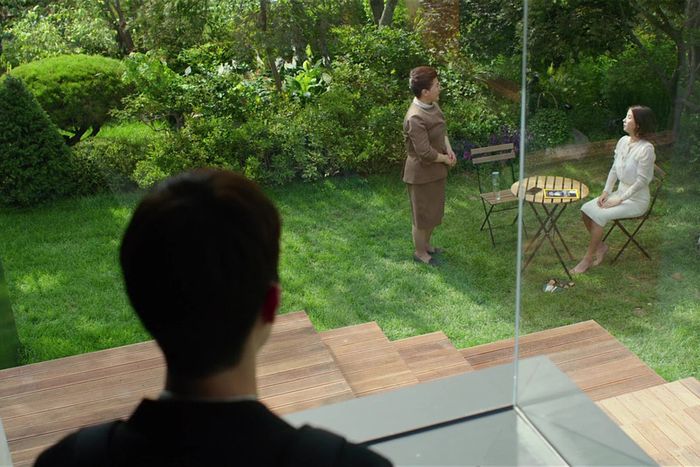
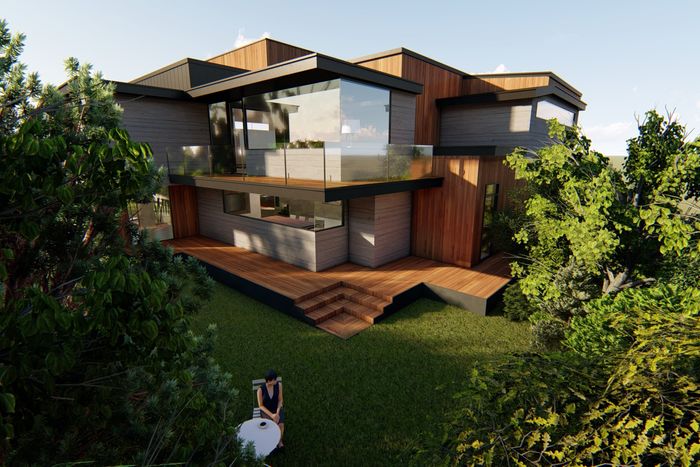
Lee had good reason to want Bong and the rest of the crew to be careful with the props: The table, constructed of cherry wood, cost $19,800; the dining table where Mrs. Park (Cho Yeo-jeong) first meets Kevin is valued at a cool $22,300; the chairs are $2,100 apiece; a brass lamp is $14,000. And as every wealthy person knows, art is a solid investment: A piece depicting a forest made of stainless-steel mesh entitled Maya 2078 by SeungMo Park costs $120,000; another of cats is priced at $50,000.
“The trash can cost like $2,300! It was German,” says Bong. “Me and my crew members were like, What the fuck? What kind of idiot would buy a trash can that’s going to smell anyway?” Still, they picked that trash can not only for its brand value, but because it was telegenic: Bong wanted one with a cinematic lid. “When you step on it to open it, it would open really smoothly, and then when you released your foot, it would quietly close like some sort of computer graphic,” he says. “Usually a trash can just closes with a clack, but when you let your foot go on this one it just went ssaaaak” — he says, using a Korean onomatopoeia that sounds similar to the doors closing on a Star Trek ship — ”and you could see it in the movie. So that’s why the German one is expensive, I guess.”
The Basement
The most kinetically charged scenes of Parasite take place up and down the stairs from the basement to the secret bunker underneath, and Lee and his team built the entire structure as a singular unit, from top to bottom, on a soundstage. The structure began at the very top: the stairs leading from the kitchen to the basement storeroom containing various fermentation projects, all of which are organized on a cabinet obscuring a hidden staircase system. The first flight of steps lead to a narrow hallway followed by another set of stairs and the eventual secret bunker, where Kun-sae, the husband of the housekeeper, has been hiding from debt collectors for years.
“The reason why we did this was there was a scene that goes down the entire space with a steady cam, and it was the director’s specific request that the scene proceeds in one breath, without stopping,” says Lee. “The set became enormous, almost to the point it was ridiculous. In the end, however, I think it was a choice very well made, especially considering the efficiency of shooting or the cast’s concentration on set. Because it is a space unfamiliar to everyone, walking down the stairs actually takes your breath away. I think acting on such a set may have helped the cast’s performance.”
The Kim Apartment
“Even Korean audiences didn’t recognize that the poor neighborhood was a set,” says Bong about the half-basement apartment the Kims reside in and the alleyway surrounding it, packed with storefronts and houses. Lee and the production team scavenged materials from neighborhoods that were in redevelopment zones set to be demolished by the government. “We constructed Ki-taek’s neighborhood with pictures taken in those areas and reminiscing about a semi-basement that I used to live in during college,” says Lee. “I used to lament my life looking at the moldy toilet, but now I found myself drawing my past.” Much of the set of Ki-taek’s home is comprised of found materials: doors, windows, tiles, bug screens, frames, and even electric wires. “They used materials that carried the wear and grime from ten, 20 years of use,” says Bong. “You have to feel that from the beginning through images, since you can’t convey it through smell.”
Moreover, they built the alley, neighboring buildings, and storefronts that the Kim house is inside as well. “The production-design team began a fun project of our own,” says Lee. “There were about 20 buildings and 40 households, and we created an individual story for each one of them.” For instance, they imagined an elderly woman who collects reusable garbage as a way she makes her living; another is a snack house piled up with fish-cake boxes and sauce containers; another is a milkman; then another a Navy veteran who runs an electrical shop. They would also place blue screens to create a visual extension for the rest of the neighborhood.
The Flood
Then came the rains. After the Kims spend most of the night hiding from the Parks underneath the living-room table, the father Ki-taek and his two children run back to their home during rains of biblical proportion. That montage, too, was shot over four different locations in Seoul, chosen for their extreme verticality, and we watch the three family members descend further and further back to their house — as if they had been cast out of heaven.
In order to flood the house and the surrounding neighborhood, the production team built the entire set inside of a massive water tank generally reserved for disaster epics just outside of Seoul. “The flood scene is so essential in the movie,” says Bong. “Much of our resources, budget, special effects, and preparation went to that scene. We had to do a lot of elaborate prepwork for a long time.”
Part of that preparation included 3-D simulations to figure out the proper camera positions, assess buoyancy levels (the Kim house is 1.5 meters below street level), stave off electrical damage, and achieve proper clay-to-water ratio to ensure accurate color and viscosity for the flooding waters. They shot the flooding sequences over the course of three days, slowly raising the water level each time. “We had calculated the amount and the level of water the set would be able to take per hour,” says Lee. “So we shot each scene at a different water level and amount. When the level was at its highest, we took the whole neighborhood into a high angle shot.”



